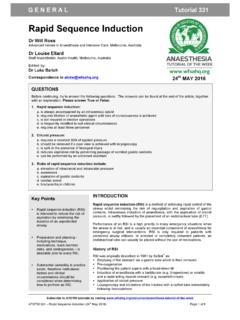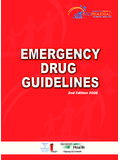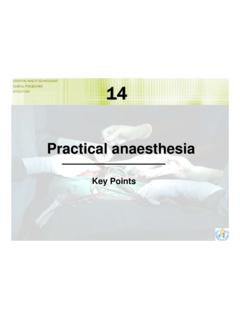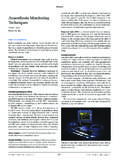Transcription of Update in Anaesthesia Clinical Overview Articles
1 Inserting peripheral intravenous cannulae tips and tricksEoin HartyCorrespondence email: - CATHETERS, CANNULAS AND VENFLONS The terminology used to describe peripheral intravenous (IV) access can be confusing to the newcomer. Cannula and catheter both mean exactly the same thing a flexible tube inserted into the body to administer or withdraw fluids or to keep another tube patent. Venflon is a trade name common in the United Kingdom. All of these terms are used interchangeably in anaesthetic rooms and operating theatres. In this article cannula will mean the whole instrument and catheter to refer to just the plastic tube that remains after withdrawal of the needle part of the SIZE CANNULA SHOULD I CHOOSE?
2 The calibre of the needle within the cannula is expressed as a Stubs iron wire gauge and illustrated in the Table 1, along with maximal flow rates through the catheter. The flow rate through the catheter is proportional to the fourth power of the radius (r4 - a simplification of Poiseuille s equation).Unfortunately different manufacturers use different colour schemes, so it is important to know the sizes and the flow rates in your hospital. Also bear in mind that flow rate varies inversely with the length of the cannula, meaning that short and thick does the trick if rapid infusion of fluid is inSummaryThe insertion of intravenous catheters is one of the most frequently performed procedures by anaesthetists.
3 It is one of the major concerns of patients and can also provoke a significant stress This article describes different types of cannula, troubleshoot common problems with cannula insertion and consider how and when to use local anaesthetic drugs in HartyCore TraineeDepartment of AnaesthesiaRoyal Devon and Exeter NHS Foundation TrustBarrack RoadExeterEX2 5 DWUKC linical Overview ArticlesThe size that you select depends on the indication for cannulation in a particular patient. Fluid and drug infusions can be run through any size cannula. Administration of fluid in shocked adult patients needs to be done rapidly, so an 18G or larger cannula is required.
4 Non-urgent blood transfusion can be reliably achieved through 18G cannulae and larger, though some units use 20G TECHNIQUE FOR CANNULA INSERTIONThe technique of cannula insertion can be taught in many different ways. The following is a combined account of techniques the author has been taught that has been modified with Prepare your patient explain what will happen and gain verbal consent. Consider using local Anaesthesia (discussed in more detail later).2. Select your site site selection is discussed in more detail below: the default position is usually the dorsal hand, forearm or antecubital fossa.
5 Apply a tourniquet proximally and encourage fist clenching to engorge the veins. Look for a straight, wide, spongy vein, with no evidence of Prepare the site with locally approved antiseptic the author s institution preference is for 2% chlorhexidine in 70% alcohol wipes, wiped for 30 seconds and left to dry before 22 Update in Anaesthesia | 1. Characteristics of different gauge cannulae Gauge Colour Maximal flow rate ( ) Time to infuse 1000ml fluid 24G ( neoflon ) yellow 13 77min 22G blue 31 32min 20G pink 67 15min 18G green 103 10min 17G white 125 8min 16G grey 236 14G brown/orange 270 e.
6 Apply digital pressure over the catheter tip and remove the needle. Attach the giving set or bung. f. Flush your cannula with saline to confirm placement, watching for extravasation of Place a locally approved dressing over the above is an ideal cannula insertion which is achieved in the majority of cases. A discussion of potential pitfalls and problems I can t find a vein This is probably the most common problem in IV cannulation, particularly in patients who have had multiple venous punctures, such as renal patients and intravenous drug abusers (IVDAs). There are two ways to solve this Warn the patient that you are starting the procedure.
7 Be honest - a small scratch is not accurate, a sharp sting may be Insert cannula with your dominant hand, using your other hand to tether and slightly stretch the skin over the target vein. a. With the bevel facing up, slide the cannula through the skin and into the vein until first flashback is seen (Figure 1a). This indicates that the needle tip has penetrated the vein. The cannula should then be angled about 5-10 degrees to the skin. b. Advance the cannula a few millimetres further to ensure the catheter as well as needle tip enters the vein (Figure 1b). c. Withdraw the needle until a second flashback is seen in the catheter itself (Figure 1c).
8 This indicates that the catheter alone is in the vein. d. Keeping the needle still, advance the catheter to the 23 Update in Anaesthesia | 1. Practical tips for venous cannulation; (a) needle in vein, catheter outside vein first flashback only; (b) needle in vein, catheter in vein first and second flashback; (c) successfully withdrawing needle and advancing catheter inside vein note second flashback in catheter(a)(b)(c)Look for alternative sitesMany longterm patients and IVDAs will be able to tell you where their best veins are. Otherwise think about insertion in: The ventral forearm or wrist this area is often overlooked and usually has some wide flat veins.
9 The inside of the wrist is a tender area with small branching veins that will only accommodate smaller cannulae. Feet veins here tend to be small and friable, but sometimes suitable veins are found over the third, fourth and fifth metatarsals. In patients who have undergone bilateral axillary clearance for breast cancer, the arm veins must be avoided and this site is usually chosen. Long saphenous vein at the ankle. This vein is found just anterior to the medial malleolus. It may be difficult to palpate, but can be located using a tap test transmission of a finger tap can be felt 2 cm proximally if there is a column of blood present.
10 This site is particularly useful in children and is almost always present if the site has not been used before (see Figure 2). Blind puncture at this site will often be successful, even if the vein cannot be palpated. This site is useful for adults undergoing superior (or cervical) mediastinoscopy, when it is useful to have reliable large bore IV access into an inferior vena cava (IVC) tributary in case a major neck vein (draining into the SVC) is damaged. Neck often the external jugular vein is prominent (Figure 3). This requires a very shallow approach (<5 degrees) and often a slight anterior-posterior bend in the needle is helpful.












